↓ Download the Full Newsletter (PDF)
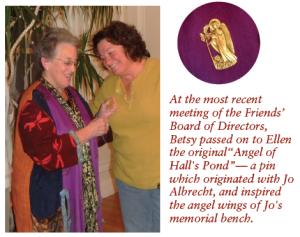 Letter from the Co-Presidents
Letter from the Co-Presidents
Frank Caro and Ellen Forrester
ANOTHER YEAR is running to the finish line. As with all of our friends and families, life sure sees changes. Hall’s Pond Sanctuary is settling in for its long winter nap with the trees, shrubs and perennial going dormant, migratory birds are flying and the animals of all varieties are settling in. This does not mean it is a time to relax. Pressures abound for our limited resources and we must be vigilant in ensuring the unique character and safety of Hall’s Pond Sanctuary. We will be vigilant in our awareness and vocalization regarding pressures regarding nearby changes and how they will affect the nature sanctuary, conservation land and wetlands.
Other changes are happening nearer to our hearts. Our beloved and fearless friend, Betsy Shure Gross is retiring from the position of Co-president of The Friends of Hall’s Pond. Along with her husband Gary and furry friend Sontu, they will be moving to California, land of no snow, children, grandchildren and great grandchildren! We wish them Bon Voyage and best wishes. It will not be the same without you, Betsy!
To our good fortune, Frank Caro has agreed to step into the position of Co-President. Frank has a long standing reputation with both The Friends of Hall’s Pond and the Town of Brookline. He has been instrumental and veryactive in leading the maintenance sessions in caring for the Sanctuary. Frank is also currently a town meeting member, a founder and cochair of the Brookline Community Aging Network, a co-chair of Brookline’s age-friendly city program, and a former board member of Brookline Green Space Alliance. As Co-President, Frank is focused on sustaining our successful collaboration with the Town in maintaining and improving the Sanctuary.
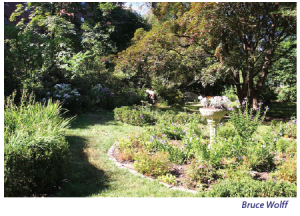
In 2016 we will be celebrating our 40th anniversary as an organization. The Sanctuary has benefited greatly from the partnership between the Town and the Friends. As a Friends group, we want to continue to attract volunteers, contribute financially, and communicate with the Conservation Commission and the Town staff about the continuing development of the Sanctuary.
We are excited about our new website: http://friendsofhallspond.org
The website is a treasure-house of information about Hall’s Pond. We encourage you to visit the website for ideas about what to see at Hall’s Pond, the history of Hall’s Pond, the conservation plan that guides maintenance and development of the Sanctuary, back issues of our newsletter, photographs, information about volunteer opportunities, membership information, and more.
Betsy was there, making it happen, right from the very start!
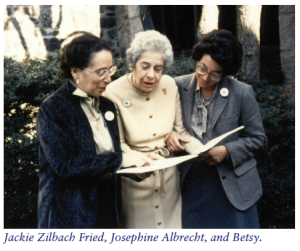
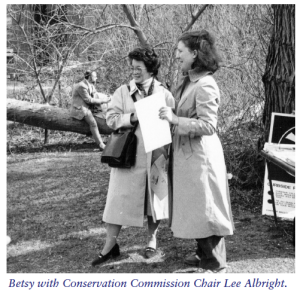
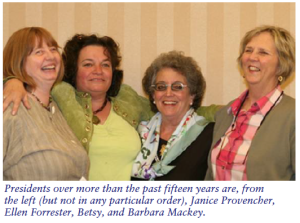
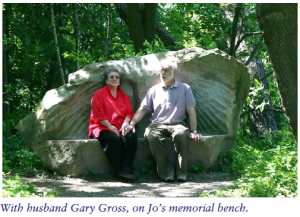
Conservation Commission
by Deborah Myers
The Conservation Commission has begun the process of preparing for the 2015 Open Space Planning Process. The kick-off meeting for the Open Space Plan Committee was held Monday, November 23rd at Town Hall. The Committee was co-chaired by Conservation Commission members Werner Lohe and Pallavi Kalia Mande and included other representatives from Town boards and commissions. The 2015 plan builds upon the 2010 Open Space Plan and continues to address the affects and opportunities of climate change, green infrastructure, and Article 97 protection for our existing network of open space in Brookline.
Through the open space planning process and the discussion of the 9th school in Town, the Commission will continue to review the opportunities for acquisition and protection of open space parcels. With the school, it will be critical to also acquire significant open space, which should be protected under Article 97. Opportunities remain within the community to protect open space on a small and large parcel scale.
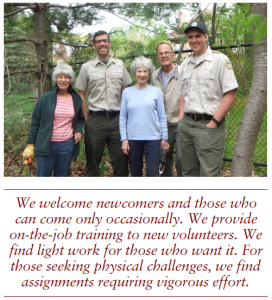 Volunteer Maintenance Team
Volunteer Maintenance Team
THE FRIENDS’ small volunteer maintenance team attends to the Sanctuary and formal garden throughout the growing season. As in other recent years, the volunteers have worked at Hall’s Pond twice a month from spring through the fall, grooming the formal garden and combatting invasive vegetation in the Sanctuary. The maintenance team supplements the work accomplished at the spring and fall Community Days. Plans for each work session are developed by the volunteers and are reviewed in advance by staff of the Conservation Commission.
During this growing season, we completed a number of special projects: planting of dog-tooth violet bulbs in the uplands east of the pond, planting new viburnums and winterberry shrubs in the formal garden, and expanding the lawn west of the pond by clearing out stubborn invasive vines and planting grass seed.
In the Sanctuary, we attend mostly to areas that have been opened to sunlight because of the loss of very large trees. Invasive vines are quick to take advantage of the extra light. By controlling the invasive vines, we provide an opportunity for native trees, shrubs, and perennials to get well established.
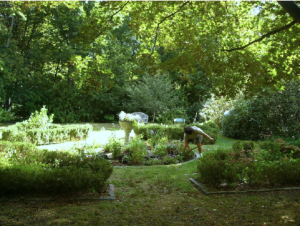 We continue to rely primarily on a small group of volunteers. Most have been active for many years. The core group consists of Priscilla Smith, Janet Wynn, Harry Breger, Helen Herman, Bruce Wolff, and Anne-Marie Kamin. This year Fran Givelber who lives on Crowninshield Road in Brookline joined the core group as an especially enthusiastic volunteer. Others who made valuable contributions included Neil Gore and Mary Klatt. Anne-Marie Kamin, Helen Herman, and Janet Wynn made particularly valuable contributions in the formal garden. Priscilla Smith, Harry Breger, Neil Gore, and Bruce Wolff devoted more attention to controlling invasive vines in the Sanctuary. Priscilla Smith learned a good deal about pruning by removing winter-damaged limbs in the large rhododendrons that surround the formal garden. Harry Breger and Bruce Wolff took photographs at the maintenance session.
We continue to rely primarily on a small group of volunteers. Most have been active for many years. The core group consists of Priscilla Smith, Janet Wynn, Harry Breger, Helen Herman, Bruce Wolff, and Anne-Marie Kamin. This year Fran Givelber who lives on Crowninshield Road in Brookline joined the core group as an especially enthusiastic volunteer. Others who made valuable contributions included Neil Gore and Mary Klatt. Anne-Marie Kamin, Helen Herman, and Janet Wynn made particularly valuable contributions in the formal garden. Priscilla Smith, Harry Breger, Neil Gore, and Bruce Wolff devoted more attention to controlling invasive vines in the Sanctuary. Priscilla Smith learned a good deal about pruning by removing winter-damaged limbs in the large rhododendrons that surround the formal garden. Harry Breger and Bruce Wolff took photographs at the maintenance session.
We have a continuing need to expand our group of volunteers. We welcome newcomers and those who can come only occasionally. We provide on-the-job training to new volunteers. We find light work for those who want it. For those seeking physical challenges, we find assignments requiring vigorous effort. We communicate through an e-mail distribution list. We are learning to take advantage of our web side. As much as possible, we schedule sessions at time convenient for members. Because most of our volunteers are retired, most of our sessions are on weekday mornings. We need to add younger volunteers. We will add weekend volunteer sessions if there is enough demand to make Saturday or Sunday sessions viable.
Frank Caro, Volunteer Coordinator frank.g.caro@gmail.com; 617-739-9228
 Pondside View: Green Heron (Butorides virescens)
Pondside View: Green Heron (Butorides virescens)
by Fred Bouchard
Photos by Bruce Wolf
AN AUGUST SIGHTING of an adult Green Heron, alertly spotted by Priscilla Smith and keenly photographed by Bruce Wolff, gives us pause to ask: was she born here or just passing through?
This smaller cousin to our familiar Great Blue Heron (14″ compared to 38″) is a cosmopolitan bird, found on several continents and in a rich variety of aqueous and riparian habitats, fresh and salt. Similarly, it hunts widely for small fish, insects, frogs, worms, crayfish, even snakes.
Despite being wid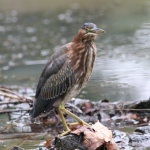 espread and rather vocal — listen for a sharp “ke-ow!”— the Green Heron is visually inconspicuous due to its preference for crepuscular feeding: like many fishermen it finds better luck at dawn and dusk than in broad daylight. It’s pretty smart, too, often dropping lures like insects and twigs as bait. They’re as agile as they are resourceful: twoweek hatchlings have been observed climbing branches to escape intruders, and swimming well after a slip off a log or avoiding terrestrial dangers.
espread and rather vocal — listen for a sharp “ke-ow!”— the Green Heron is visually inconspicuous due to its preference for crepuscular feeding: like many fishermen it finds better luck at dawn and dusk than in broad daylight. It’s pretty smart, too, often dropping lures like insects and twigs as bait. They’re as agile as they are resourceful: twoweek hatchlings have been observed climbing branches to escape intruders, and swimming well after a slip off a log or avoiding terrestrial dangers.
What’s green about it? You might well ask. Its name seems a misnomer: with a slate-gray crown, breast streaked cinnamon and white, and yellow to orange legs, the only hint of ‘green’ shows in a slight olive cast to its slaty-blue wings.
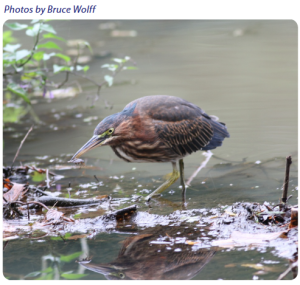 Green Herons visit Massachusetts between late April and late October. My Hall’s Pond notes show sporadic sightings of spring migrants in the 1990s and 2003, when a male and female were spotted pondside on consecutive days in early May. Though I have tracked down no conclusive Hall’s Pond breeding records, it’s a likely possibility — as these colorful if elusive herons have been noted summering and nesting elsewhere along Boston’s Emerald Necklace, albeit in diminishing numbers.
Green Herons visit Massachusetts between late April and late October. My Hall’s Pond notes show sporadic sightings of spring migrants in the 1990s and 2003, when a male and female were spotted pondside on consecutive days in early May. Though I have tracked down no conclusive Hall’s Pond breeding records, it’s a likely possibility — as these colorful if elusive herons have been noted summering and nesting elsewhere along Boston’s Emerald Necklace, albeit in diminishing numbers.
